Honeycomb, a New Food Resource with Health Care Functions: The Difference of Volatile Compounds found in Apis cerana and A. mellifera Honeycombs
Abstract
1. Introduction
2. Materials and Methods
2.1. Honeycomb Samples
2.2. Sample Preparation
2.3. GC-MS Conditions
2.4. Qualitative and Quantitative Analysis
2.5. Statistical Analysis
3. Results
3.1. Characterisation of the Volatile Composition
3.2. PCA
3.3. OPLS-DA
4. Discussion
5. Conclusions
Supplementary Materials
Author Contributions
Funding
Data Availability Statement
Conflicts of Interest
References
- Fratini, F.; Cilia, G.; Turchi, B.; Felicioli, A. Beeswax: A minireview of its antimicrobial activity and its application in medicine. Asian Pac. J. Trop. Med. 2016, 9, 817–821. [Google Scholar] [CrossRef] [PubMed]
- Hepburn, H.; Pirk, C.; Duangphakdee, O. Honeybee Nests; Springer: Berlin/Heidelberg, Germany, 2016. [Google Scholar]
- Giampieri, F.; Quiles, J.L.; Orantes-Bermejo, F.J.; Gasparrini, M.; Forbes-Hernandez, T.Y.; Sánchez-González, C.; Llopis, J.; Rivas-García, L.; Afrin, S.; Varela-López, A.; et al. Are by-products from beeswax recycling process a new promising source of bioactive compounds with biomedical properties? Food Chem. Toxicol. 2018, 112, 126–133. [Google Scholar] [CrossRef] [PubMed]
- Zhao, H.; Zhu, M.; Wang, K.; Yang, E.; Su, J.; Wang, Q.; Cheng, N.; Xue, X.; Wu, L.; Cao, W. Identification and quantitation of bioactive components from honeycomb (Nidus Vespae). Food Chem. 2020, 314, 126052. [Google Scholar] [CrossRef] [PubMed]
- Guan, X.; Zhou, Y.; Liang, X.; Xiao, J.; He, L.; Li, J. Effects of compounds found in Nidus Vespae on the growth and cariogenic virulence factors of Streptococcus mutans. Microbiol. Res. 2012, 167, 61–68. [Google Scholar] [CrossRef] [PubMed]
- Felicioli, A.; Cilia, G.; Mancini, S.; Turchi, B.; Galaverna, G.; Cirlini, M.; Cerri, D.; Fratini, F. In vitro antibacterial activity and volatile characterisation of organic Apis mellifera ligustica (Spinola, 1906) beeswax ethanol extracts. Food Biosci. 2019, 29, 102–109. [Google Scholar] [CrossRef]
- Wang, X.; Rogers, K.M.; Li, Y.; Yang, S.; Chen, L.; Zhou, J. Untargeted and targeted discrimination of honey collected by Apis cerana and Apis mellifera based on volatiles using HS-GC-IMS and HS-SPME-GC-MS. J. Agric. Food Chem. 2019, 67, 12144–12152. [Google Scholar] [CrossRef] [PubMed]
- Xu, P.; Shi, M.; Chen, X.-X. Antimicrobial peptide evolution in the Asiatic honey bee Apis cerana. PLoS ONE 2009, 4, e4239. [Google Scholar] [CrossRef] [PubMed]
- Kumar, L.V. Propolis in dentistry and oral cancer management. N. Am. J. Med. Sci. 2014, 6, 250–259. [Google Scholar] [CrossRef]
- Przybylek, I.; Karpinski, T.M. Antibacterial properties of propolis. Molecules 2019, 24, 17. [Google Scholar] [CrossRef] [PubMed]
- Drescher, N.; Klein, A.-M.; Neumann, P.; Yanez, O.; Leonhardt, S.D. Inside honeybee hives: Impact of natural propolis on the ectoparasitic mite varroa destructor and viruses. Insects 2017, 8, 15. [Google Scholar] [CrossRef] [PubMed]
- Mura, A.; Pusceddu, M.; Theodorou, P.; Angioni, A.; Floris, I.; Paxton, R.J.; Satta, A. Propolis consumption reduces nosema ceranae infection of european honey bees (Apis mellifera). Insects 2020, 11, 124. [Google Scholar] [CrossRef] [PubMed]
- Pusceddu, M.; Floris, I.; Mura, A.; Theodorou, P.; Cirotto, G.; Piluzza, G.; Bullitta, S.; Angioni, A.; Satta, A. The effects of raw propolis on Varroa-infested honey bee (Apis mellifera) workers. Parasitol. Res. 2018, 117, 3527–3535. [Google Scholar] [CrossRef] [PubMed]
- Pusceddu, M.; Piluzza, G.; Theodorou, P.; Buffa, F.; Ruiu, L.; Bullitta, S.; Floris, I.; Satta, A. Resin foraging dynamics in Varroa destructor-infested hives: A case of medication of kin? Insect Sci. 2019, 26, 297–310. [Google Scholar] [CrossRef] [PubMed]
- Kasote, D.M. Propolis: A neglected product of value in the Indian beekeeping sector. Bee World 2017, 94, 80–83. [Google Scholar] [CrossRef]
- Lee-Rangel, H.A.; Mendoza-Martinez, G.D.; de León-Martínez, L.D.; Relling, A.E.; Vazquez-Valladolid, A.; Palacios-Martínez, M.; Hernández-García, P.A.; Chay-Canul, A.J.; Flores-Ramirez, R.; Roque-Jiménez, J.A. Application of an electronic nose and HS-SPME/GC-MS to determine volatile organic compounds in fresh mexican cheese. Foods 2022, 11, 1887. [Google Scholar] [CrossRef]
- Pellati, F.; Prencipe, F.P.; Benvenuti, S. Headspace solid-phase microextraction-gas chromatography-mass spectrometry charac-terization of propolis volatile compounds. J. Pharm. Biomed. Anal. 2013, 84, 103–111. [Google Scholar] [CrossRef]
- Isidorov, V.; Bakier, S.; Grzech, I.J.J.o.C.B. Gas chromatographic–mass spectrometric investigation of volatile and extractable compounds of crude royal jelly. J. Chromatogr. B-Anal. Technol. Biomed. Life Sci. 2012, 885, 109–116. [Google Scholar] [CrossRef]
- Lv, S.; Wu, Y.; Li, C.; Xu, Y.; Liu, L.; Meng, Q. Comparative analysis of pu-erh and fuzhuan teas by fully automatic headspace solid-phase microextraction coupled with gas chromatography-mass spectrometry and chemometric methods. J. Agric. Food Chem. 2014, 62, 1810–1818. [Google Scholar] [CrossRef]
- Kaskoniene, V.; Venskutonis, P.R.; Ceksteryte, V. Composition of volatile compounds of honey of various floral origin and bee-bread collected in Lithuania. Food Chem. 2008, 111, 988–997. [Google Scholar] [CrossRef]
- Kumar, S.; Bajpai, V.; Singh, A.; Kumar, B. Identification, characterization and distribution of terpene indole alkaloids in etha-nolic extracts of Catharanthus roseus using high-performance liquid chromatography/electrospray ionization quadrupole time-of-flight tandem mass spectrometry and the study of their geographical variation. Rapid Commun. Mass Spectrom. 2018, 32, 319–332. [Google Scholar] [CrossRef]
- Bankova, V.; Popova, M.; Trusheva, B.J.C.C.J. Propolis volatile compounds: Chemical diversity and biological activity: A review. Chem. Cent. J. 2014, 8, 28. [Google Scholar] [CrossRef] [PubMed]
- Kamatou, G.; Sandasi, M.; Tankeu, S.; van Vuuren, S.; Viljoen, A. Headspace analysis and characterisation of South African propolis volatile compounds using GCxGC-ToF-MS Rev Bras Farmacogn-Braz. Res. J. Pharmacogn. 2019, 29, 351–357. [Google Scholar] [CrossRef]
- Luo, L.; Fu, Y.; Xu, Y.; Chen, B.; Li, Y. Volatile components of propolis collected from different areas of china. In Proceedings of the 2009 International Conference of Natural Product and Traditional Medicine, Shangxi Xian, China, 1 January 2009. [Google Scholar]
- Tomaszewski, M.; Dein, M.; Novy, A.; Hartman, T.G.; Steinhaus, M.; Luckett, C.R.; Munafo, J.P. Quantitation and seasonal variation of key odorants in propolis. J. Agric. Food Chem. 2019, 67, 1495–1503. [Google Scholar] [CrossRef] [PubMed]
- Park, S.N.; Lim, Y.K.; Freire, M.O.; Cho, E.; Jin, D.C.; Kook, J.K. Antimicrobial effect of linalool and alpha-terpineol against perio-dontopathic and cariogenic bacteria. Anaerobe 2012, 18, 369–372. [Google Scholar] [CrossRef] [PubMed]
- Jing, L.; Lei, Z.; Li, L.; Xie, R.; Xi, W.; Guan, Y.; Sumner, L.W.; Zhou, Z. Antifungal activity of Citrus Essential oils. J. Agric. Food Chem. 2014, 62, 3011–3033. [Google Scholar] [CrossRef]
- Inouye, S.; Takizawa, T.; Yamaguchi, H. Antibacterial activity of essential oils and their major constituents against respiratory tract pathogens by gaseous contact. J. Antimicrob. Chemother. 2001, 47, 565–573. [Google Scholar] [CrossRef]
- Nair, M.K.M.; Joy, J.; Vasudevan, P.; Hinckley, L.; Hoagland, T.A.; Venkitanarayanan, K.S. Antibacterial effect of caprylic acid and monocaprylin on major bacterial mastitis pathogens. J. Dairy Sci. 2005, 88, 3488–3495. [Google Scholar] [CrossRef]
- Nair, M.K.M.; Vasudevan, P.; Hoagland, T.; Venkitanarayanan, K. Inactivation of Escherichia coli O157:H7 and Listeria mon-ocytogenes in milk by caprylic acid and monocaprylin. Food Microbiol. 2004, 21, 611–616. [Google Scholar] [CrossRef]
- Hameskocabas, E.E.; Demirci, B.; Uzel, A.; Demirci, F.J.J.o.M.P.R. Volatile composition of Anatolian propolis by headspace-solid-phase microextraction (HS-SPME), antimicrobial activity against food contaminants and antioxidant activity. J. Med. Plant Res. 2013, 7, 2140–2149. [Google Scholar] [CrossRef]
- Machado, A.M.; Miguel, M.G.; Vilas-Boas, M.; Figueiredo, A.C. Honey volatiles as a fingerprint for botanical origin-a review on their occurrence on monofloral honeys. Molecules 2020, 25, 32. [Google Scholar] [CrossRef]
- Siegmund, B.; Urdl, K.; Jurek, A.; Leitner, E. "More than honey": Investigation on volatiles from monovarietal honeys using new analytical and sensory approaches. J. Agric. Food Chem. 2018, 66, 2432–2442. [Google Scholar] [CrossRef]
- Lilley, B.D.; Brewer, J.H. The selective antibacterial action of phenylethyl alcohol. J. Pharm. Ences 1953, 42, 6–8. [Google Scholar] [CrossRef] [PubMed]
- Bianchi, F.; Careri, M.; Musci, M. Volatile norisoprenolds as markers of botanical origin of Sardinian strawberry-tree (Arbutus unedo L.) honey: Characterisation of aroma compounds by dynamic headspace extraction and gas chromatography-mass spectrometry. Food Chem. 2005, 89, 527–532. [Google Scholar] [CrossRef]
- Zhu, Y.-J.; Zhou, H.-T.; Hu, Y.-H.; Tang, J.-Y.; Su, M.-X.; Guo, Y.-J.; Chen, Q.-X.; Liu, B. Antityrosinase and antimicrobial activities of 2-phenylethanol, 2-phenylacetaldehyde and 2-phenylacetic acid. Food Chemistry. 2011, 124, 298–302. [Google Scholar] [CrossRef]
- Dev, U.; Devakumar, C.; Mohan, J.; Agarwal, P.C. Antifungal activity of aroma chemicals against seedborne fungi. J. Essent. Oil Res. 2004, 16, 496–499. [Google Scholar] [CrossRef]
- Farag, M.A.; Hegazi, N.; Dokhalahy, E.; Khattab, A.R. Chemometrics based GC-MS aroma profiling for revealing freshness, origin and roasting indices in saffron spice and its adulteration. Food Chem. 2020, 331, 127358. [Google Scholar] [CrossRef]
- Kiran, I.; Özşen, Ö.; Çelik, T.; İlhan, S.; Gürsu, B.Y.; Demirci, F. Microbial transformations of isophorone by alternaria alternata and neurospora crassa. Nat. Prod. Commun. 2013, 8, 59–61. [Google Scholar] [CrossRef]
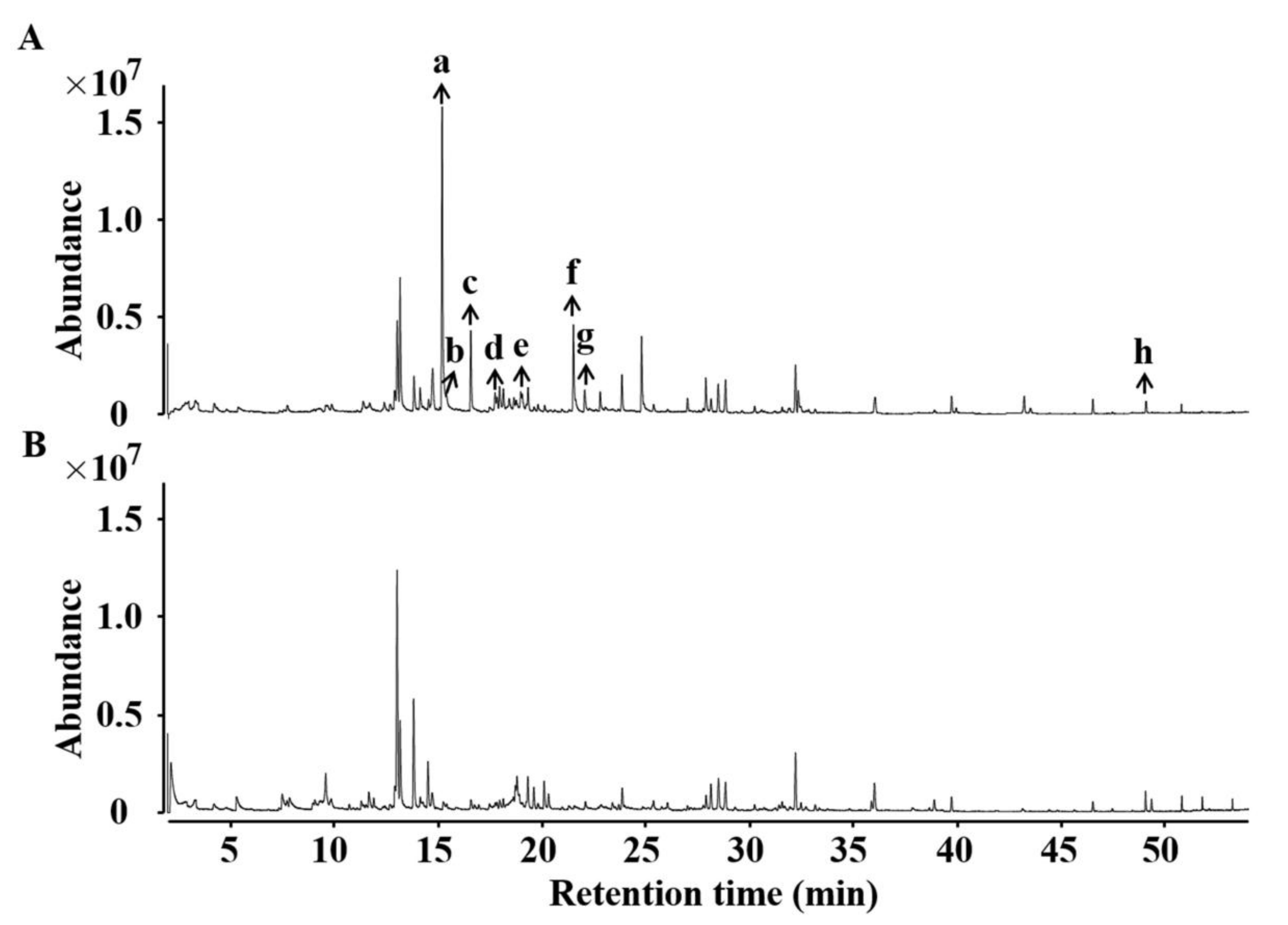
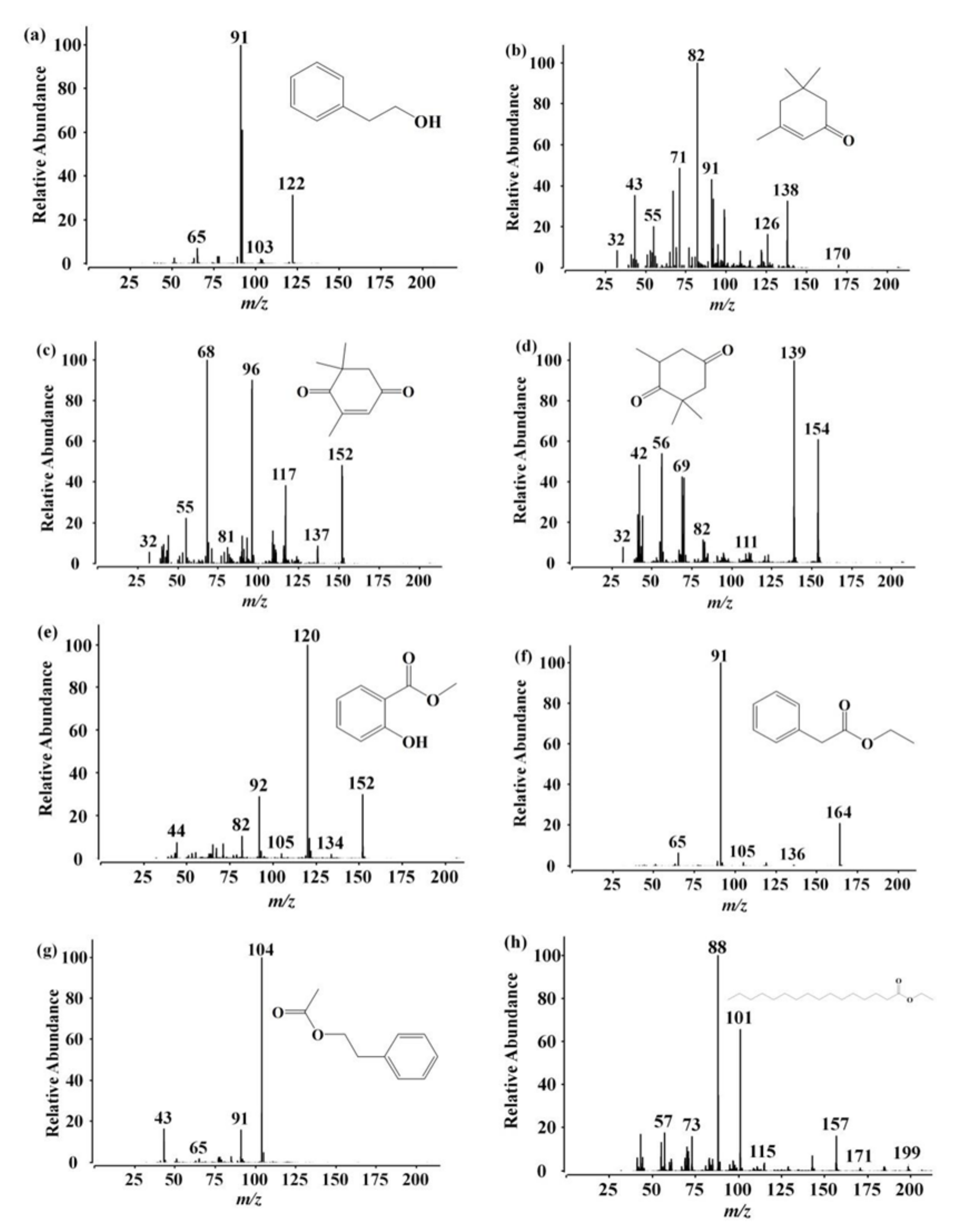
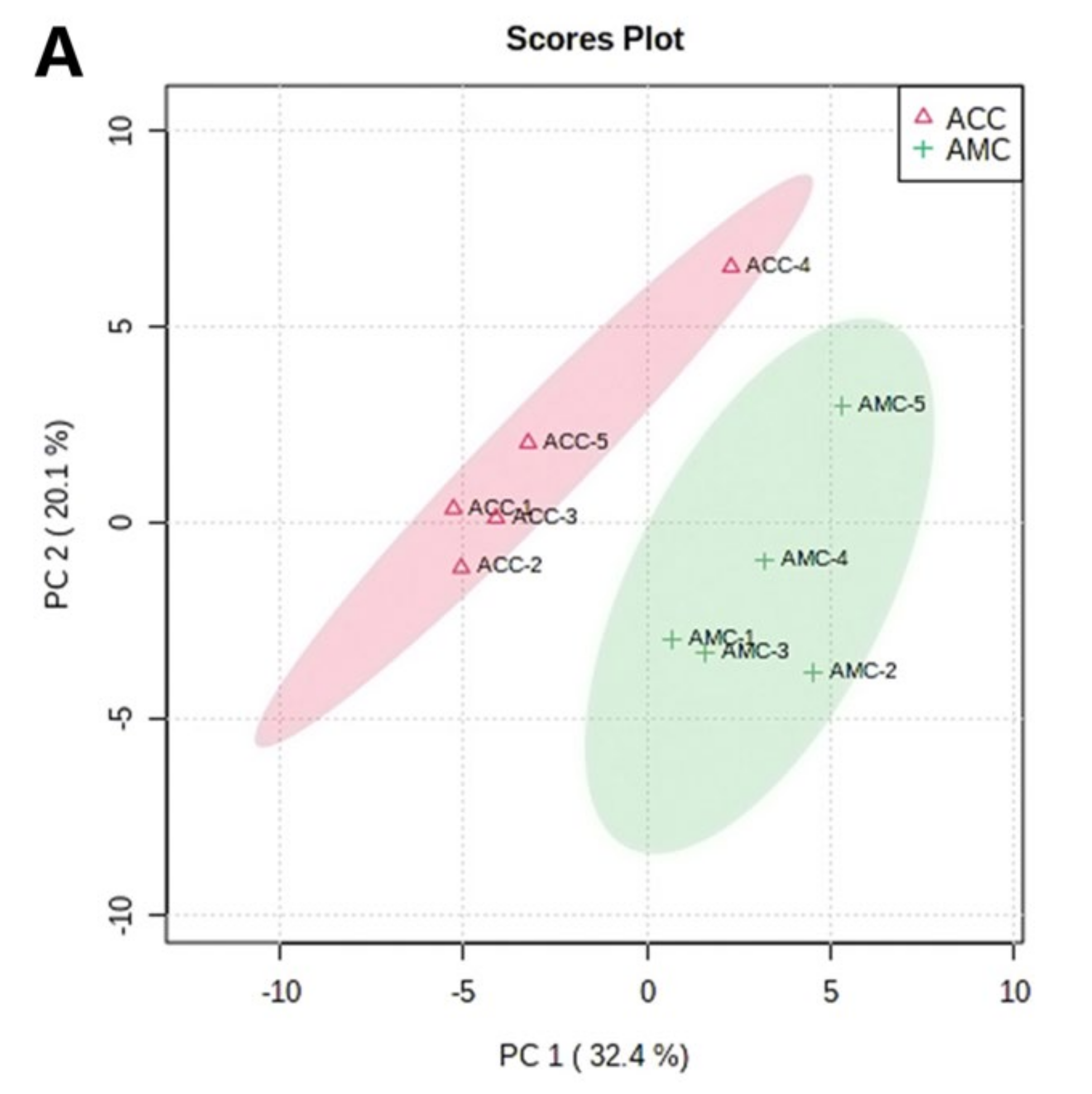
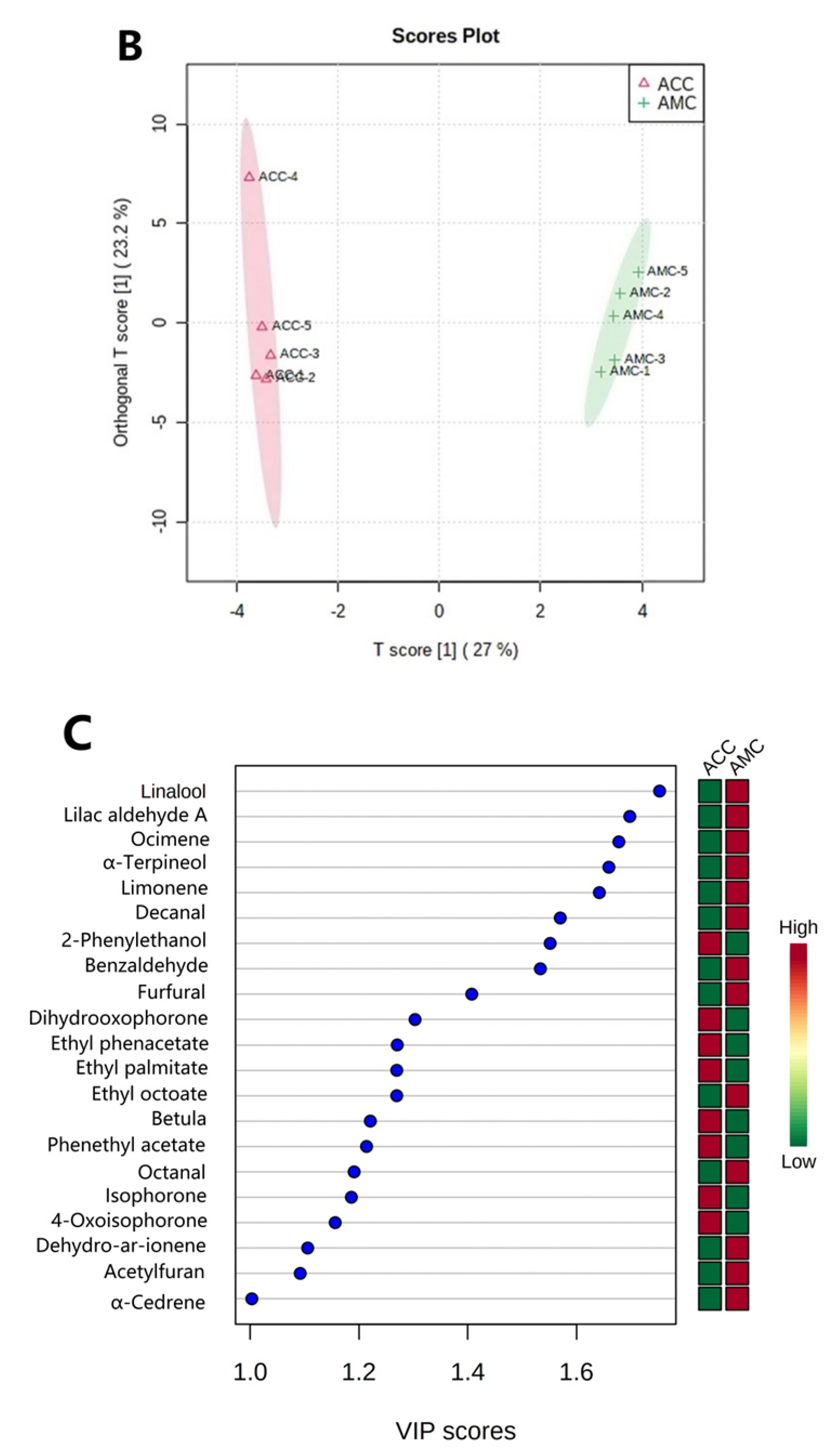
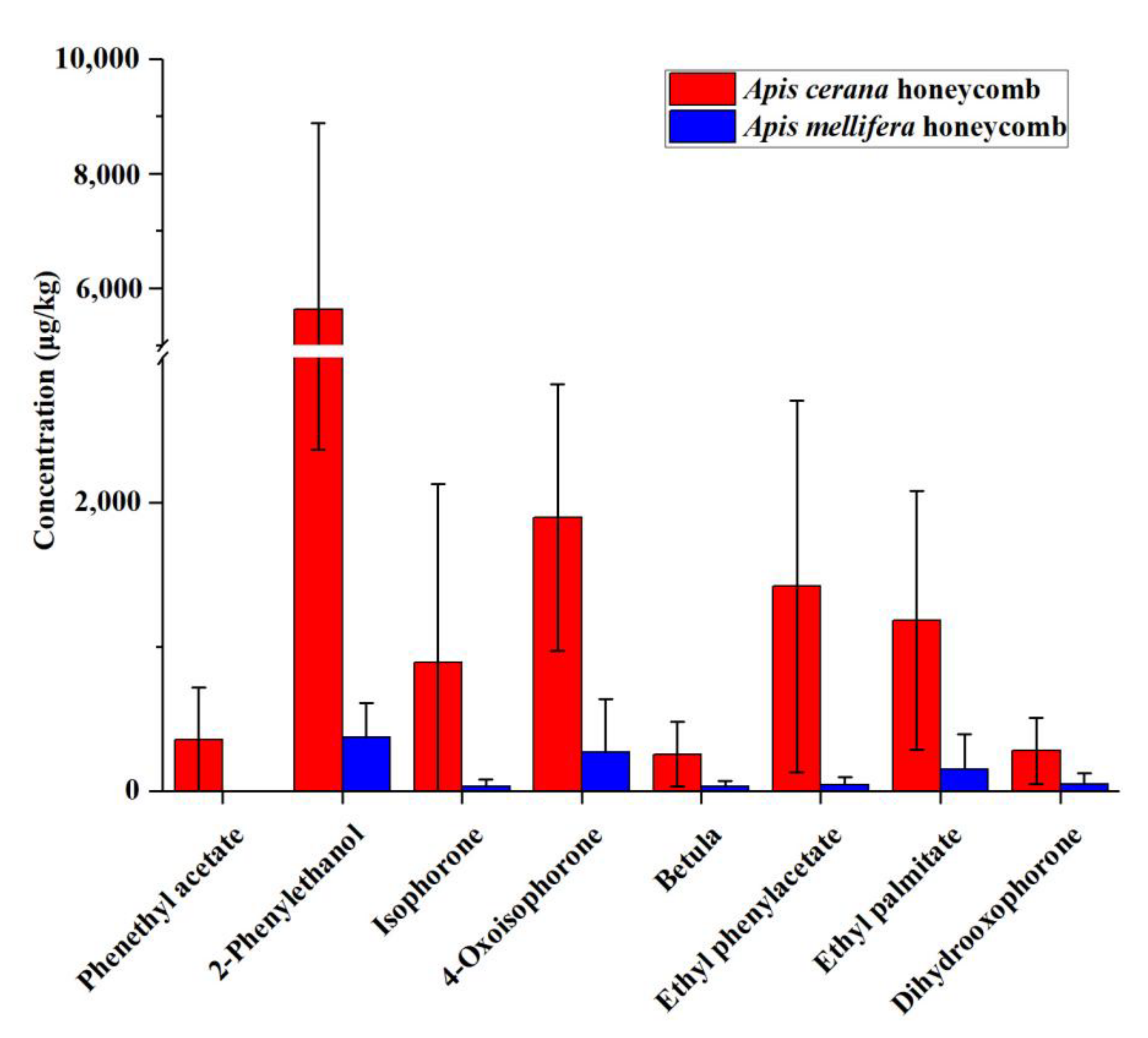
| Compound Type | Numbers | Total Content µg/kg (Range) | |
|---|---|---|---|
| ACC (n = 5) | AMC (n = 5) | ||
| Aldehydes | 11 | 4761.29 (1292.83–10,141.32) | 7056.93 (3681.69–10,560.34) |
| Hydrocarbons | 13 | 2914.96 (855.18–4979.14) | 2436.3 (888.12–4019.27) |
| Ketones | 11 | 4534.38 (2420.21–7892.92) a | 931.61 (238.2–1556.39) b |
| Esters | 26 | 7707.52 (2721.26–13,400.18) a | 2154.96 (268.96–5424.89) b |
| Terpenes | 38 | 16,081.19 (1706.25–41,958.44) | 8510.35 (1848.85–24,193.50) |
| Alcohols | 3 | 6008.73 (3127.71–11,434.83) a | 435.41 (189.43–780.95) b |
| Others | 12 | 990.67 (0–1701.63) | 1834.5 (114.53–4954.57) |
| Compounds | CAS No. | RT | RIa | RIb | Major Ions | Propolis | Reference |
|---|---|---|---|---|---|---|---|
| Acetylfuran | 1192-62-7 | 5.299 | 916 | 915 | 95, 101, 42, 67 | − | |
| Benzaldehyde | 100-52-7 | 7.484 | 961 | 961 | 106, 105, 77 | + | [22,24] |
| Octanal | 124-13-0 | 9.606 | 1005 | 1001 | 43, 56, 84, 69 | + | [22] |
| Limonene | 138-86-3 | 10.725 | 1027 | 1030 | 68, 93, 44, 136 | + | [22] |
| Ocimene | 13877-91-3 | 11.894 | 1051 | 1044 | 93, 91, 97, 136 | − | |
| Linalool | 78-70-6 | 14.510 | 1103 | 1104 | 93, 71, 121, 43 | + | [22] |
| Lilac aldehyde A | 53447-46-4 | 16.954 | 1153 | 1154 | 71, 55, 93, 43 | − | |
| α-terpineol | 10482-56-1 | 18.801 | 1191 | 1187 | 121, 93, 59, 136 | + | [22,24] |
| Ethyl octoate | 106-32-1 | 19.315 | 1202 | 1196 | 88, 101, 57, 127 | − | |
| Decanal | 112-31-2 | 19.591 | 1208 | 1195 | 57, 82, 70, 43 | + | [22] |
| Dehydro-ar-ionene | 30364-38-6 | 26.043 | 1351 | 1349 | 157, 142, 172, 44 | − | |
| α-cedrene | 469-61-4 | 28.488 | 1408 | 1408 | 119, 93, 161, 105 | + | [24] |
| Compounds | CAS No. | RT | RI a | RI b | Major Ions | Bioactivity | Reference |
|---|---|---|---|---|---|---|---|
| 2-Phenylethanol | 60-12-8 | 15.232 | 1118 | 1114 | 91, 92, 122, 65 | Antibacterial, antifungal | [36,37] |
| Isophorone | 78-59-1 | 15.391 | 1121 | 1118 | 82, 71, 91, 138 | Antibacterial | [39] |
| 4-Oxoisophorone | 1125-21-9 | 16.573 | 1145 | 1142 | 68, 96,152,117 | NT | |
| Dihydrooxophorone | 20547-99-3 | 17.753 | 1169 | 1170 | 139, 154, 56, 42 | NT | |
| Betula | 119-36-8 | 19.063 | 1196 | 1187 | 120, 152,92, 65 | Antibacterial | [39] |
| Ethyl phenylacetate | 101-97-3 | 21.551 | 1250 | 1244 | 91,164, 65 | NT | |
| phenethyl acetate | 103-45-7 | 22.060 | 1261 | 1244 | 104, 43,91 | Antifungal | [37] |
| Ethyl palmitate | 628-97-7 | 49.060 | 1998 | 1996 | 88, 101, 43,57 | NT |
Publisher’s Note: MDPI stays neutral with regard to jurisdictional claims in published maps and institutional affiliations. |
© 2022 by the authors. Licensee MDPI, Basel, Switzerland. This article is an open access article distributed under the terms and conditions of the Creative Commons Attribution (CC BY) license (https://creativecommons.org/licenses/by/4.0/).
Share and Cite
Guo, X.; Liang, Y.; Yi, S.; Qiu, S.; Liu, M.; Ning, F.; Luo, L. Honeycomb, a New Food Resource with Health Care Functions: The Difference of Volatile Compounds found in Apis cerana and A. mellifera Honeycombs. Foods 2022, 11, 3204. https://doi.org/10.3390/foods11203204
Guo X, Liang Y, Yi S, Qiu S, Liu M, Ning F, Luo L. Honeycomb, a New Food Resource with Health Care Functions: The Difference of Volatile Compounds found in Apis cerana and A. mellifera Honeycombs. Foods. 2022; 11(20):3204. https://doi.org/10.3390/foods11203204
Chicago/Turabian StyleGuo, Xiali, Yanlang Liang, Shengxiang Yi, Shengrong Qiu, Mingyan Liu, Fangjian Ning, and Liping Luo. 2022. "Honeycomb, a New Food Resource with Health Care Functions: The Difference of Volatile Compounds found in Apis cerana and A. mellifera Honeycombs" Foods 11, no. 20: 3204. https://doi.org/10.3390/foods11203204
APA StyleGuo, X., Liang, Y., Yi, S., Qiu, S., Liu, M., Ning, F., & Luo, L. (2022). Honeycomb, a New Food Resource with Health Care Functions: The Difference of Volatile Compounds found in Apis cerana and A. mellifera Honeycombs. Foods, 11(20), 3204. https://doi.org/10.3390/foods11203204








